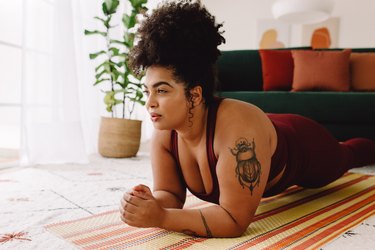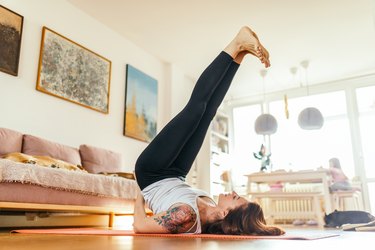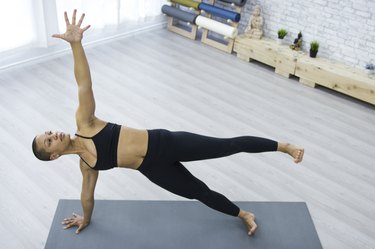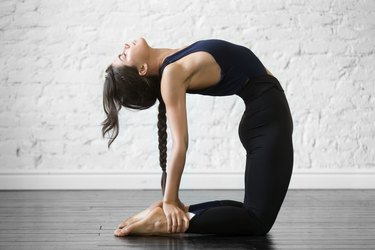
Spines have a slight natural curve front to back, but 2 to 3 percent of people have a condition called scoliosis, which is when the spine curves sideways to the left or the right, according to the American Association of Neurological Surgeons.
The condition is most often diagnosed between the ages of 10 and 15 when the spine is still developing, but it can affect people throughout the lifespan. Adults are much more likely to experience pain, not from the curvature itself but from the strain it puts on certain muscles and joints, says Matthew E. Cunningham, MD, PhD, associate professor of orthopaedic surgery at the Hospital for Special Surgery in New York and head of the hospital's scoliosis clinic.
Video of the Day
Video of the Day
Here are the symptoms and causes of the condition, how it's diagnosed and ways to find scoliosis pain relief.
Symptoms of Scoliosis
Scoliosis may come with no symptoms at all. When it does, says Claire McKeone, PT, DPT, a board-certified clinical specialist in orthopaedic physical therapy at Cincinnati Children's Hospital, "The main thing we see is a change in shape when you look straight from your back. I don't see a straight line. I see an 'S' shape or a 'C' shape."
Sometimes a shoulder, hip or even a rib juts out, a result of your spine also twisting and rotating. Your head may even be out of alignment with the rest of your body.
Causes of Scoliosis Pain
Scoliosis pain in adults can affect the lower back and also cause pain shooting down the leg, says Dr. Cunningham. If there's pressure on certain nerves, your legs may also feel weak.
"The world is built for people who don't have scoliosis, so those who do are always accommodating," McKeone says. That puts stress on one side of your body, which is what causes the pain.
In general, here's what causes scoliosis, which can lead to pain:
1. Idiopathic
Nothing you do — like toting a heavy backpack or lifting groceries — can cause scoliosis itself. Instead, 80 percent of cases are "idiopathic," meaning no one knows what causes them.
2. Certain Conditions
Cerebral palsy, muscular dystrophy, other neuromuscular diseases, a birth defect or a spinal injury can also cause scoliosis.
3. Degenerative
In older adults, scoliosis is either left over from childhood or is degenerative, meaning it results from accumulated wear-and-tear on your body as it ages. Degenerative scoliosis usually affects the lumbar or lower back and the pain can come from pinched nerves or from certain muscles and joints that have to work more to compensate for the curve.
How Scoliosis Is Diagnosed
The only way to diagnose scoliosis definitively is through an X-ray, Dr. Cunningham says. Sometimes it's an accidental finding on an X-ray originally ordered for a different reason, like a sports injury.
Otherwise, a doctor who suspects scoliosis may request an X-ray after physically examining the patient and performing an Adams Forward Test. This is when you stand with your back towards the doctor and bend 90 degrees at the waist, with your arms hanging by your sides. If one side of your body is raised or one shoulder, rib or hip is higher than the other, the doctor might order an X-ray to confirm or rule out scoliosis.
The severity of the curve is determined via the Cobb Method, which measures the degree of the curvature. Scoliosis is diagnosed when the sideways curvature is more than 10 degrees. The higher the number, the more severe the scoliosis.
If one of your symptoms is pain, doctors may also order other tests to see if you have another medical condition. Other sources of back pain include infection, fracture, lack of vitamin D, arthritis, sprains, strains and more, Dr. Cunningham says.
"Scoliosis doesn't stop you from doing anything. The more you understand your curve, the more likely you are to get in the best version of your posture."
The Best Treatments to Help Ease Scoliosis Pain

Children and adolescents with scoliosis rarely have pain. Instead, treatment (if any) aims to stop the curve from getting worse while increasing function. That treatment may be a brace or, in severe cases, surgery.
In adults, several options can help with scoliosis pain, including many at-home remedies:
1. Pain Relievers
You might start with nonsteroidal anti-inflammatory drugs (NSAIDs) like aspirin or ibuprofen (Advil). Acetaminophen (Tylenol) doesn't reduce inflammation but may help with pain.
After over-the-counter options, doctors sometimes turn to prescription nerve and seizure drugs like gabapentin (Neurontin) as well as the antidepressants duloxetine (Cymbalta) and bupropion (Wellbutrin), which interrupt pain signals traveling to your brain, says Dr. Cunningham.
2. Warm or Cold Therapy
Applying ice or heat to the affected area may provide some relief, Dr. Cunningham says.
3. Physical Therapy and Exercise
Movement can usually help anyone with scoliosis, regardless of the Cobb angle or the age, and these types of exercises can typically be done at home.
While specific exercises must be geared to each individual, the general aim is to strengthen the muscles that support your spine, Dr. Cunningham says. Physical therapy takes a similar approach. "We want to provide symmetry to the muscle strength and muscle length," says APTA spokesperson Nancy Durban, PT, DPT.
If you're not sure which exercises might help you, consider working with a physical therapist, who can tailor a movement plan to your fitness level and degree of scoliosis.
4. The Schroth Method
This is a type of physical therapy that uses exercises tailored to each patient's particular curve, explains Durban, who is also lead physical therapist at Cincinnati Children's Pain Clinic.
"It looks at the muscle, symmetry and alignment of the posture and incorporates breathing to realign the rotation of the spine to improve posture control and function."
Among other things, patients learn how to achieve a corrected posture themselves and receive instruction in performing activities of daily living like bathing, adds McKeone, who is a certified Schroth therapist.
5. Alternative Therapies
Yoga and pilates both build core strength and balance, which are helpful in scoliosis, and they have other benefits, too.
"You have a mind-body component, so you're building body awareness, which is especially important in scoliosis," says McKeone. "Scoliosis doesn't stop you from doing anything. The more you understand your curve, the more likely you are to get in the best version of your posture."
6. Spinal Injections
These are usually injections of steroids and a local anesthetic given directly to the painful area. But it's a temporary fix, with results lasting a few weeks or months.
7. Surgery
Surgery is a last step typically reserved for patients who have pain regardless of how big or small the scoliosis is, says Dr. Cunningham. There are different types of lumbar decompression surgery:
- Laminectomy: Doctors remove a section of one your vertebrae to free a nerve from pressure.
- Discectomy: Doctors remove a section of one of the discs separating the vertebrae, also to relieve pressure.
- Spinal fusion: Doctors fuse or join two or more vertebrae together to strengthen the spine. "Fusion is a big undertaking," says Dr. Cunningham. "Once you do it, it can alter the mechanics of the spine and potentially offload that motion to levels above and below, so they may wear out faster and end up being symptomatic."
- Mayo Clinic: “Scoliosis”
- Cleveland Clinic: “Adult Scoliosis”
- American Association of Neurological Surgeons: “Scoliosis”
- National Library of Medicine: “Scoliosis”
- American Academy of Orthopaedic Surgeons: “Idiopathic Scoliosis in Children and Adolescents”
- Hospital for Special Surgery: “Scoliosis"
- National Institute of Arthritis and Musculoskeletal and Skin Diseases: “Scoliosis in Children and Teens”
- National Health Service UK: “Scoliosis"
- Scoliosis and Spinal Disorders: “2011 SOSORT guidelines: Orthopaedic and Rehabilitation treatment of idiopathic scoliosis during growth”
- American Council on Exercise: “Exercises for Scoliosis: How to Develop Programs for Clients with Scoliosis”
- National Health Service UK: “Scoliosis Treatment in Adults”
Is this an emergency? If you are experiencing serious medical symptoms, please see the National Library of Medicine’s list of signs you need emergency medical attention or call 911.



